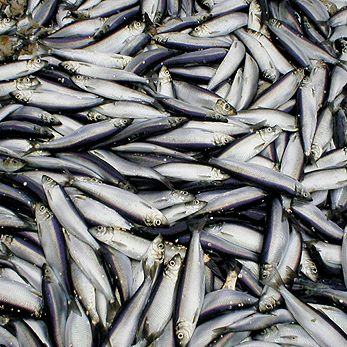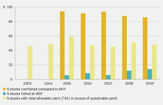What are the problems?
A range of direct and indirect effects
Fisheries have a range of direct and indirect effects on marine ecosystems. Fishing causes the death of many species including those being targeted and a range of other species such as non-targeted invertebrates and fish (including sharks), seabirds, turtles and marine mammals (seals and small cetaceans). Excessive fishing pressure on targeted species may lead to impaired reproductive capacity and a risk of stock collapse. Deep-water species have been shown to be particularly sensitive to fishing pressure. Some unwanted by-catch is discarded at sea. Discard rates have been high in some North-East Atlantic fisheries and were estimated to amount to 1.4 million tonnes in the early 2000s. Discards have been shown to affect the structure of biological communities. Fish are discarded for a variety of reasons. There are strong economic incentives in many fisheries to discard fish to maximise the value of the landing (‘high-grading’). This is illegal under all fisheries policies.
Certain types of fishing gear physically disturb or damage the seabed and so affect benthic habitats and communities, including those which OSPAR has listed as threatened and/or declining, such as seamounts and cold-water coral reefs.
Fishing causes changes in community structure and marine food webs, which may be irreversible. The depletion of larger predatory species has strong effects on fish community structure. Recent research has shown that impacts from fishing on the abundance of fish can be transmitted into deep offshore areas below the maximum depth of commercial operations. While certain impacts of fishing are inevitable, one longstanding challenge of sustainable fisheries management is to minimise long-term negative effects on ecosystems while seeking long-term economic and social viability of the fisheries.
Most fisheries are fully exploited
Most traditional fish stocks in the OSPAR area, and indeed globally, are fully exploited, overexploited or depleted Figure 8.2. Of the 600 global marine fish stocks monitored by the UN Food and Agriculture Organization (FAO), 3% are underexploited, 20% are moderately exploited, 52% are fully exploited, 17% are overexploited, 7% are depleted and 1% are recovering from depletion.
North-East Atlantic fisheries peaked at 13 million tonnes in 1976 and have since fallen to around 10 million tonnes a year. Higher yields, more security of supply and lower environmental impacts would follow from reductions in fishing effort. All OSPAR countries are committed to implementing an ecosystem-based approach to fisheries management and use of the precautionary approach.
Constant change makes management challenging
Fisheries management is challenging because fisheries are constantly changing. There may be changes in the availability of commercial species, changes in the market price, changes in capital and fuel costs, or changes in the regulatory regime. New fisheries develop to meet market demand or when effort is diverted from other fisheries. Areas fished change, for example, as fish stocks and migration patterns respond to environmental change, when technical developments allow new areas to be exploited or as a result of management, such as closed areas. Management of deep-sea fisheries is difficult due to a lack of data underpinning stock assessments.
Fishing may increase the vulnerability of ecosystems
Fish stocks are an integral part of ecosystems and, as such, are both strongly dependent on, and support, the good health of the ecosystem. Altered community structure and marine food webs therefore affect commercial fish stocks, particularly during periods of environmental change. In combination with other environmental impacts, such as pollution, climate change and ocean acidification, the effects of fishing may increase the vulnerability of ecosystems.


